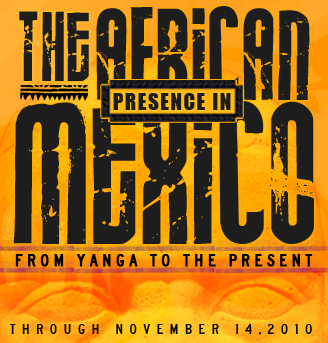If you have not yet experienced The African Presence in Mexico: From Yanga to the Presence at DuSable Museum, it is not too late. The exhibit closes on Sunday, November 14th. The is a free museum day.
I took the time to visit it last week and learned some intriguing facts.
- African ancestry was pretty much erased from Mexican history books even though Dr. Gonzalo Aguirre Beltran’s research in the 1940s concluded that Africans lived in Mexico. The Mexican government finally recognized “Africa as Mexico’s ‘Third Root'” after Native American and Spanish heritage in the 1990s.
- The Portuguese started the African slave trade in the 1440s.
- Slavery in Mexico was abolished in Mexico at least 30 years before slave in America ended.
- As with any culture, there were stereotypes based on color, class and economic status.
- There is research that shows that Africans were present in Mexico prior to Christopher Columbus in 1492.
- There were several periods in history when Africans and Mexicans were connected not by race but by roots, resistance and recognition. Harlem Renaissance was such a time.
- Mexico allowed African Americans many social freedoms in the 1920s they were denied in the United States.
These are just some of the facts I learned, and the artwork is absolutely mesmerizing. Be sure to stop through if you haven’t done so already. DuSable Museum is located at 740 East 56th Place in Chicago’s Hyde Park community.
If you have already visited The African Presence in Mexico, what did you think of the exhibit?


I saw the exhibit in August and was happy I did. I never thought about Africans in Mexico. And there were so many Mexicans at DuSable. That definitely brought people together
This was my first visit to DuSable Museum and I have lived in Chicago all of my life. I was surprised to see so few black people. Everyone there was either white or of Hispanic heritage. The receptionist was really nice. I’ll be going back soon.
Thanks for sharing your experience. I never thought about Africans in Mexico either. But, I can say I am happy that I did see the exhibit. I’ll try to get in earlier next time.
It’s good you took the time to do something different. I have to admit that I’ve been negligent in checking out all the culture our great city has to offer. But, like you, I’ll be going back soon, too.
I visited the museum for the first time, it was god to know specific details about the African presence in Mexico something I never taught about, now knowing it was just kind off wiped out of the History….
Did you enjoy your experience at the museum? I was totally in awe of the information I learned about Africans in Mexico. I never really considered it. When I read that they were wiped out of history books, I thought about African American history in the United States. As I conduct research on black history, it is sooooo difficult to find any information. So, I guess that’s the plight of having African Roots on this continent.
Hello it the real Mexican people that no it history Mexico was ruled by a lot of euro that why it seem very crazy to hear of this I’m very proud of my three roots
Well, I’m glad I could share some history. It was a fascinating exhibit.
Olmec head stones where not made by Africans. If you see the Huchole people, you will see that they are not African, and they look like the head stones. And there are many head stones made in different time periods and different regions of Mexico. They are a mixture of a man an Jaguar. There were no metal tools, animals, or fruits from Africa in Mexico. I think if African would have made that long of a journey, they would have taken animals, food, and metal tools with them.
Thanks for sharing this information, Joe.